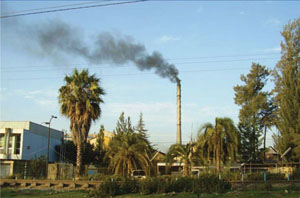2.5.2 Pollution sources and categories
Pollutants can come from natural or man-made sources. Examples of natural sources of pollution are volcanoes which give out ash and dust into the atmosphere and metals such as arsenic which are naturally present in some rocks and soils. Man-made pollutants can come from industrial, domestic (home), transport and agricultural sources.
Think of one example of a pollutant from industrial, domestic (home), transport and agricultural sources.
There are lots of different examples that you could think of. Here are some that we came up with:
- Industrial sources: sewage discharged into water bodies; air emission of smoke released to the atmosphere (see Figure 2.5).
- Domestic sources: cooking and heating that releases smoke to the atmosphere. Solid waste and liquid waste are other forms of pollutants that can be released to water bodies and soil.
- Transport: discharge of air pollutants from various types of vehicles. Heavy trucks and diesel engine vehicles are much more polluting than a petrol engine.
- Agricultural sources: organic wastes such as agriculture residues, animal dung and wastes from agriculture-based plants.
 Figure 2.5 Air pollution from an industrial source. (Photo: Abera Kumie)
Figure 2.5 Air pollution from an industrial source. (Photo: Abera Kumie)
Pollution can take many forms. The air we breathe, the water we drink, the soil where we grow our food, and even the increasing noise we hear every day all contribute to health problems and a lower quality of life. Pollution can be classified as:
- Air pollution: the release of chemicals and particulates into the atmosphere.
- Water pollution: the release of wastes, chemicals and other contaminants into surface and groundwater.
- Soil pollution: the release of wastes, chemicals and other contaminants into soil.
- Radioactive pollution: presence of radioactive substances in the environment.
- Noise pollution: unacceptable levels of noise in work, residential and recreational places.
- Thermal pollution: the release of heat into the environment; for example heated water into a river.
Air pollution
This occurs with the release of chemicals in gaseous or dust form into the atmosphere. Household cooking, industries, vehicles and incinerators are common sources of air pollution.
Water pollution
Water can be polluted by the release of liquid waste (human, animal or industrial) into rivers, streams and lakes. A common type of water pollution is organic material such as human and animal wastes and in waste water from food processing. These wastes can be removed from rivers and lakes by the self-cleaning processes described above but, if present in large quantities, the biodegradation process can reduce the level of dissolved oxygen in the water so much that fish and other aquatic life cannot survive. As well as these environmental impacts, water contaminated with human waste is a significant cause of many diseases that will be described in more detail elsewhere in this Module. Some pollutants can be extremely harmful even if they are taken in small quantities and may cause cancer, reproductive health effects (abortion, embryo malformation, birth defects) or nerve damage when the contaminated water is consumed.
Land/soil pollution
This occurs when land is used as a site for accumulating wastes that are generated from various sources (industry, agriculture, health facilities, villages, private and public organisations). These wastes may be biologically, chemically or physically hazardous to plants and animals. The pollution by chemicals such as pesticides may have long-term consequences, such as groundwater pollution.
2.5 Environmental pollution
